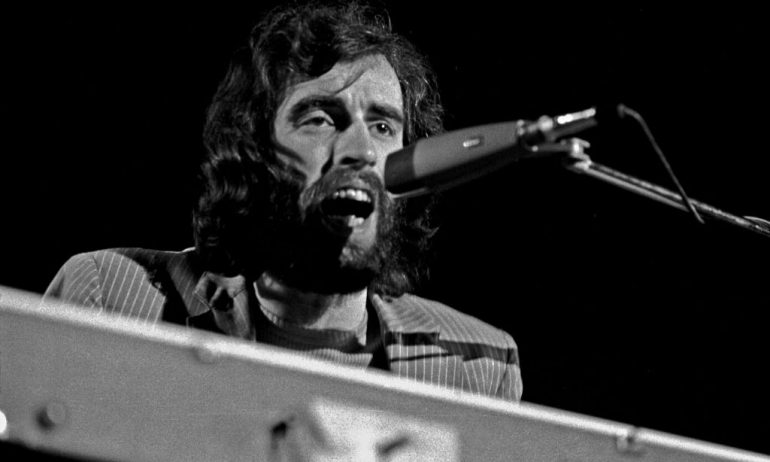“Richard Manuel was a whole show unto himself. He was hot. He was about the best singer I’d ever heard; most people said he reminded them of Ray Charles. He’d do those ballads, and the ladies would swoon. To me that became the highlight of our show.” – Levon Helm
The Band has gone down in history as one of the greatest musical collectives in rock history. But one member who is frequently given short shrift for his contribution is Richard Manuel.
Because The Band had multiple vocalists, and other members Robbie Robertson and Levon Helm have made significant musical achievements since their breakup, history has perhaps not been as kind to Richard as he deserves. As he was in many ways the “lead” lead singer.
What he brought to The Band was a degree of vocal versatility which his fellow musicians lacked. His voice had a distinct range, running the whole gamut from a rich, soulful baritone to a high, fragile falsetto. He was also the pianist, drawing influence from his heroes like Ray Charles.
Embed from Getty ImagesRichard Manuel – Early Life
Richard Manuel grew up in Stratford, Ontario, and at age fifteen he joined a local band, The Rebels, as the piano player. After a couple of years paying his dues in the touring circuit, he was cherry-picked by Canadian rock ‘n’ roll star Ronnie Hawkins to play piano in his backup band the Hawks. That was 1961, and he never looked back.
The line-up of the Hawks would soon evolve into its own beast, The Band. He and his fellow bandmates, Robbie Robertson, Levon Helm, Garth Hudson, and Rick Danko, quickly grew disillusioned with Ronnie’s approach to music and the rock ‘n’ roll lifestyle.
He disdained marijuana and current music trends. This strain of antagonism between Ronnie and his backing band reached its natural conclusion in 1964 when they parted company for good.
They now found themselves in the awkward position of a backing band without a lead singer. Levon was their de facto leader, purely by virtue of the length of time he had spent with Ronnie Hawkins.
They toured for the next year or so as the Levon Helm Sextet, the Canadian Squires and finally Levon and the Hawks. In his role as a pianist, Richard quickly distinguished himself as a capable vocalist and performed the majority of their numbers live.
However, when famed blues musician John Hammond was looking for a backup band for his new album So Many Roads, he sought out the Hawks on account of their reputation for solid musicianship. In the event, only Levon, Garth and Robbie played on the album. But the kudos they received as “The Hawks” led to none other than Bob Dylan seeking them out when he was looking to make a drastic change to his signature sound.
Since the dawn of the ’60s, Bob Dylan had established himself as one of the greatest and most politically engaged folk singers of his generation. But when he opted to ditch the solo acoustic guitar sound that had endeared him to the folk community, he had no idea what an impact it would have in the world of music and in the wider counter-cultural realm of the mid-1960s.
This was in many ways a baptism of fire for the Hawks, whom Dylan chose to be his backing band on his now-legendary 1966 world tour where he debuted his new sound. The fans who had once praised Dylan for his folk credentials now turned on him dramatically for his perceived betrayal. This led to Richard Manuel and his bandmates getting caught in the crossfire, frequently subjected to booing and mass-walkouts at the shows.
Big Pink
But in their role as Dylan’s backing band, Richard and his fellow musicians knew they were in it for the long haul. When Dylan suffered a motorbike smash in 1967, he briefly withdrew from touring to recuperate in Woodstock, New York with his then-wife Sara Dylan. But he had paid his musicians a retainer and put them up in a rented asbestos-clad pink house known as “Big Pink.”
In many ways, this was the birth of The Band. Living together at Big Pink, they began to write and produce their own material, experimentally blending genres like gospel, blues, soul, and country. This was the culmination of all their hard work during their years on the road.
Their positive reputation and their association with Dylan led to The Band signing a ten-album contract with Capitol Records in 1968, and they quickly got to work on their debut album. The now-legendary result of these sessions, Music from Big Pink, features four original compositions by Richard Manuel, including “Tears of Rage,” which he co-wrote with Bob Dylan himself.
During this period, many of Richard Manuel’s songs were popularly covered; “Blues for Breakfast” by Cass Elliot, “Tears of Rage” by Joan Baez, and “In a Station” by Karen Dalton.
The success of this album gave Richard a sense of financial security which he had never before experienced. He married his longtime girlfriend, Jane Kristiansen, and gloried in the increasing popularity and acclaim The Band was enjoying. However, he also lapsed into heroin use at this time. This would have a dramatic impact on his life and career, as well as his creative output.
The Band
Tensions soon began to emerge between members of The Band when it was generally understood that Robbie Robertson was attempting to take the bulk of the credit for songwriting and compositions. As such, when the next album, The Band, was released in 1969, Richard’s credits on the album proved limited. Even though it has since been the subject of dispute as to just how much of the material he actually wrote for the album.
Embed from Getty ImagesBy the third album, Stage Fright, he achieved just two co-writing credits. This is generally perceived to be the result of behind the scenes chicanery. On account of the fact that the biggest money-making aspect of the music business came at that point from songwriting credits.
Of course, it didn’t help matters that Richard Manuel’s drug abuse and alcoholism were gathering pace. By the time of The Band’s fourth album, Cahoots, was released in 1971, relationships among the musicians were fractious and Richard’s songwriting and performance capabilities were in decline.
It got so bad that it began to effect The Band as a whole, making live performances difficult and causing them to limit their touring schedule.
To shake things up a little, they opted to relocate to Malibu and to record an album of covers of blues and R&B standards. The hope was that this might shake them from their entropy and restore their creative music-making mentality.
Although Richard Manuel was drinking heavily and pretty strung out throughout the recording, his performances on the resultant album, Moondog Matinee, have been universally acclaimed. It seems that music was one of the few things that kept him on the straight and narrow during this dark period.
Embed from Getty ImagesGradually throughout 1973, The Band began to resume their touring. They appeared on bills with The Grateful Dead, playing open-air festivals and stadium shows. And later that year they backed Dylan once again on his Planet Waves album, which featured one of his biggest hits “Forever Young.”
In the first part of 1974, Dylan and The Band headed out on the road for a series of joint shows featuring sets by both artists. The resulting live album, Before the Flood, shows Richard still at the height of his vocal powers, producing dizzying falsettos.
When the Dylan tour was over, The Band remained on the road, supporting artists like Crosby, Stills, Nash and Young, Joni Mitchell and The Beach Boys on an arduous stadium tour. Richard had by now switched from heroin to cocaine and his health and sobriety were in constant flux. It is reported that he attempted suicide at least twice during 1976, while at the height of his substance abuse. Truly, he was at his lowest ebb.
The Last Waltz
The Band played their last full show with their original line-up in 1976. This was filmed by Martin Scorsese for his famed concert film The Last Waltz. Over the next couple of years, The Band drifted apart, and by 1978 they were no longer a functioning group. Around this time, Richard Manuel took the opportunity to enter into rehab and get himself sober for the first time in years.
In 1980, he and former bandmate Rick Danko began touring as an acoustic duo in a series of low-key shows. He still struggled with writer’s block, though by this point a reunion with The Band seemed inevitable.
When they did finally get back together in 1983, it was without Robbie Robertson, who had given up touring entirely after The Last Waltz. But Richard’s musicianship and vocal abilities which had deserted him during the years of his drug addiction allowed him to play the songs he had previously been unable to, and the shows were largely successful.
But the pressure was getting to Richard. He lapsed back into drug addiction and alcoholism, even resorting to theft to fund his habits. Though The Band was still receiving critical acclaim, their commercial prospects had declined and they found themselves playing smaller venues.
Depression and disillusionment took their toll, as well as his further descent into addiction, and he took his own life in March of 1986.
Though Richard Manuel is best remembered as part of a wider musical collective, he brought a unique creative sensibility to The Band. Without him, they would never be the same again.
Similar Stories…
- Cathy Smith & “The Band Baby”
- Lowell George – The Little Feat Frontman That Died Too Young
- Clarence White – Innovator, Guitarist, and Pioneer of Country Rock
- The Alice Cooper Fact Sheet – 5 Things You Need To Know - January 12, 2023
- Everybody Knows The Words, But What Is Hotel California About? - April 29, 2022
- What Is The Meaning Of Stairway To Heaven: Led Zeppelin’s Amazing 1971 Musical Epic? - April 24, 2022


